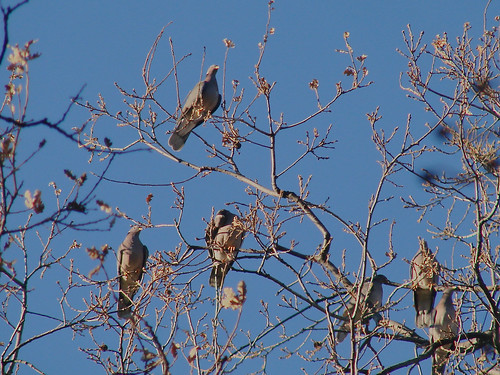
Well, these plump and not-so-bright birds saw their numbers diminish as the local wildlife warmly welcomed them - to dinner. My infrequent explorations found 5-6 different spots where pigeon dinner parties played out. I'm sure there were more.

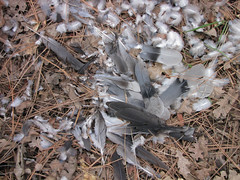
My guess is that Mrs. Owl (and her son li'l horny) enjoyed the most pigeon tartar. Most of the remains were just feathers, and raptors prefer to pluck before they eat. The cooper's hawk I've seen around probably feasted too - they mostly hunt birds.
One day on a lakeside stroll, I found a freshly dead one. Perhaps it had gotten scared and flown into a tree. Or maybe the cold had taken it. Like the poor doe that passed before, I figured I'd leave it unburied and point a cam trap at it to see what cleaned it up. In fact, having just gotten my brand new super-fast Reconyx RC60 trail camera, I decided to set both it and the older Moultrie Game Spy I60 to get multiple angles and compare the performance of the two.
I thought the pigeon would disappear in a night or so, but much like the doe, the snow had other plans. It was quickly buried. And I had to go. So, I decided to leave the new Reconyx on it for a few weeks, and move the Moultrie elsewhere. Fortunately, enough visitors had already come by to give me a pretty good first comparison of the two cameras.
Reconyx vs. Moultrie
While it was a very casual and non-scientific head-to-head, the results highlight the big difference between the two cams: speed. The Moultrie is a tad slow to wake and take - especially at night. This slowness can translate into missed or blurry shots (animals moving while the slow shutter is snapping or between shots). The new Reconyx, however, is designed to wake fast and fire shots rapidly. About 1/second in fact.
A huge testimony to this difference are these pics of a jackrabbit that sauntered by - the Moultrie captured it in 2 shots, while the Reconyx captured it in 15. Yes - 15. It took 3 bursts of 5 pics each (I had set it for bursts of 5 and the Moultrie at its max which is 3). In fact, the Reconyx was so fast that it actually captured a single IR flash from the Moultrie across 2 of its pics!
Reconyx shots #1-3:

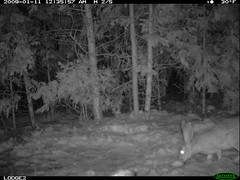
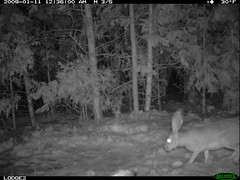
First Moultrie shot:
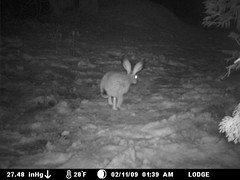
Reconyx shot #4, with IR flash from first Moultrie shot:
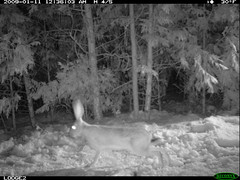
Reconyx shots #5-8:
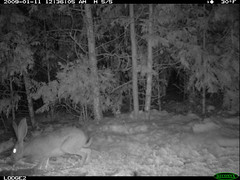
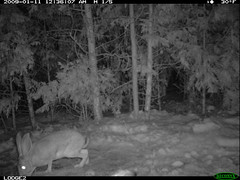
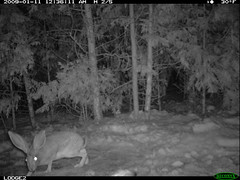
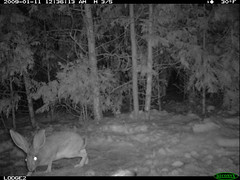
Second (and final) Moultrie shot:
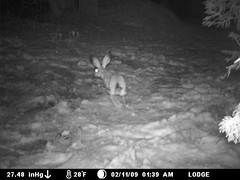
Reconyx 9 & 10 - both caught second Moultrie IR flash:
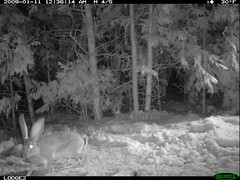
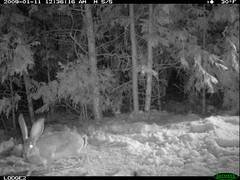
Reconyx #11-15:

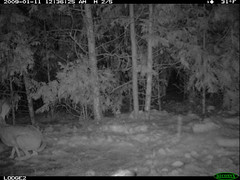
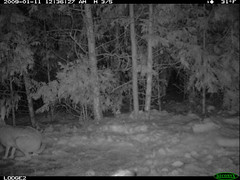
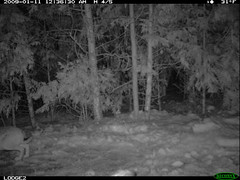

Note how the faster shots of the Reconyx help keep the images sharper. Btw - I left these pics unedited to give the best comparison (And yes, I know the month is set wrong on the Reconyx).
A few other comparison pics side-by-side:

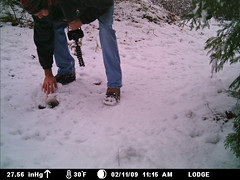
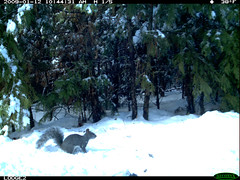
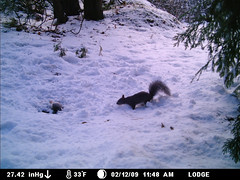
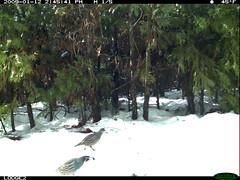

But What Happened to the Pigeon?
The snow dwindled on day 11 and the pigeon disappeared that night. Twelve different species of critter traipsed the trail or dropped in to check out the flattened fowl - 9 mammals and 3 birds. Well, 10 mammals - visiting humans also stopped to look at the bird and feathers. :)
Mammals: deer, jackrabbit, gray squirrel, woodrat, mouse, skunk, opossum, bobcat & fox.
Birds: quail, varied thrush & raven.
Mule deer walked by often, browsing on buck brush and looking unhappy with the snow. As with the doe carcass, they almost always stopped and sniffed the bird. Fascinating. They also seem to like the new camera - many came in close for an inspection.
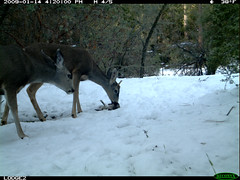


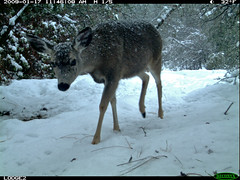
Jackrabbits came by frequently too. Some solo, some in pairs. And gray squirrels of course. One even looks like he's trying to take a bite. Evidently, squirrels will scavenge and eat meat when they're hungry and can't find other food. Such as in Winter.
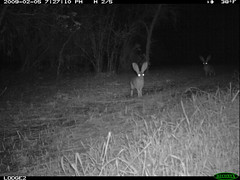
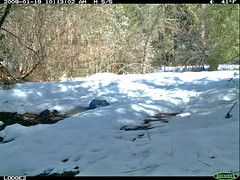
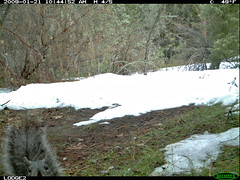
The mouse and woodrat were a surprise. Shows just how sensitive the new Reconyx is - it snapped pics of a scampering woodrat that was almost 20 feet away!


The skunk was also a surprise. It's the first I've caught on the trail cams. There hasn't seemed to be any around since the great horned owl cleaned up the last one over a year ago (lacking a good sniffer, they're the top predator of skunks).
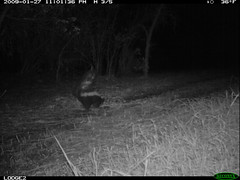

I'm sure the bobcat & fox woulda snarfed it, but like the skunk, they came too late.
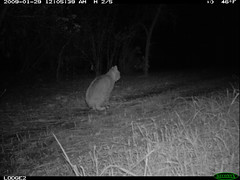
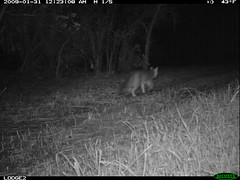
Unfortunately, the pigeon's last dinner party wasn't all that exciting. It was eaten up in two snacks on day 11. A raven came by for lunch and tore off a chunk, and an opossum came by that night and shuffled off with the rest. So, mystery solved: the possum pinched the pigeon.
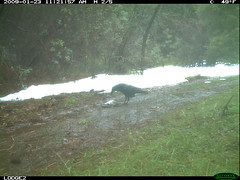

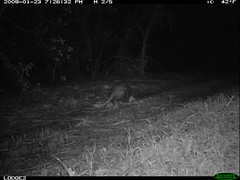

Other looky-loos:
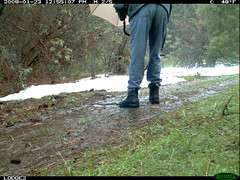

Also always interesting are the critters that were NOT seen. No coyotes came by. No black bears either - still hibernating of course. And, no cougar. Guessing the one that was recently shot and killed nearby was the one we've been seeing. I haven't gotten a single pic of it since the shooting, nor have I seen any sign on the trails (tracks, scat or kills).
Last, and oh so weird, is this jackrabbit portrait. Does he think the cam trap is a TV? Is he captivated by the little red glow the IR flash gives off? Is he waiting to be taken up to the mother ship? Is he trying to telepathically link with the cam? Or, is he just a camera 'ho? Gotta love bizarre and interesting animal behavior.
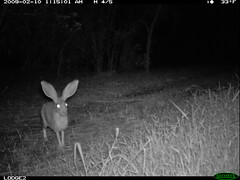

====
Related factoids:
- Pigeons and doves are in the same family and the two words are pretty interchangeable. "Dove" is generally used to describe small ones, and "pigeon" large ones.
- Domestic pigeons were selectively bred from Rock Pigeons, and have been domesticated for over 5,000 years (perhaps 10,000). They're mentioned on Mesopotamian tablets and in Egyptian hieroglyphics. They're bred for food, racing, homing and fanciness (picture Westminster with lots of cooing and poop).
- More than 30 domestic pigeons have received medals for their work in saving human lives (most were war-time messengers).
- Homing pigeons use the magnetic field of the Earth to navigate and can return home from over 600 miles away. This amazing ability is quite unusual for birds that don't migrate.
- The famous Passenger Pigeon went from billions and billions in 1871 to extinction in 1914. The main cause: we ate them.
References:
- Wikipedia - Band-tailed Pigeon
- Wikipedia - Domestic Pigeon
- Cornell Lab of Ornithology - All About Birds: Band-tailed Pigeon
- John Muir Laws - The Laws Field Guide to the Sierra Nevada

Thanks for the comparison of the cams. It's great to see the differences and get your assessment.
ReplyDeleteThanks Codger. Hoping to get a custom cam like you and Cliff use, but haven't been able to find one that does IR flash yet.
ReplyDeleteWhat a great way to experiment with the new cam. The side-by-side examples were revealing...and speed of new trap is impressive. Looking forward to future catches.
ReplyDelete